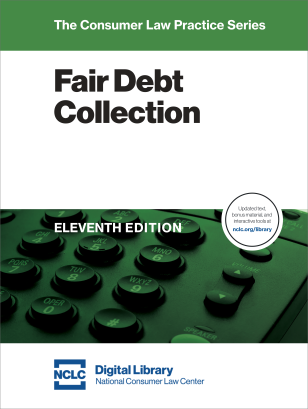The Supreme Court’s 2016 decision in
Spokeo, Inc. v. Robins, 136 S. Ct. 1540, 1547, 194 L. Ed. 2d 635 (2016), continues to bedevil FDCPA cases. In
Spokeo, the Supreme Court vacated a Ninth Circuit decision that held that a litigant had standing under Article III of the Constitution to pursue a Fair Credit Reporting Act claim. The Court remanded the case to the Ninth Circuit to evaluate whether the litigant had alleged a sufficiently “concrete” injury to constitute an injury-in-fact, and it sketched out some of the criteria for determining when an intangible injury is concrete.
Since
Spokeo, a motion to dismiss for lack of Article III jurisdiction can be expected in almost every FDCPA case. Even if the defendant has not made such a motion, Article III goes to subject matter jurisdiction, so the court—even a court of appeals—can raise the issue
sua sponte.
The first two years of decisions applying
Spokeo to FDCPA claims have overwhelmingly found standing. However, several of the favorable circuit-level decisions are unreported, and, of the five reported decisions, two—both from the Sixth Circuit—find a lack of standing. Consumer attorneys risk not only losing a case but also undermining the viability of FDCPA claims in their circuit if they do not prepare FDCPA cases with
Spokeo in mind and brief the
Spokeo issues carefully.
NCLC’s new
Fair Debt Collection (9th ed. March 2018) (2 vol. 1774 pp.) contains a new
§ 11.10 that analyzes in depth all FDCPA
Spokeo court decisions. NCLC has also just updated that print edition’s analysis with almost 100 new
Spokeo decisions, making the treatise’s digital version virtually up-to-the-minute. This article provides ten practice pointers on overcoming
Spokeo challenges, with live links to
Fair Debt Collection’s updated digital version, including the 100 new cases.
Tip # 1: Carefully Interview the Client Concerning Any Type of Harm Suffered
Always interview the consumer in detail about all harm caused by the FDCPA violation. Consumers may be reluctant to confess the fear that a collection effort caused them, or to admit how confused they were, so may not volunteer this information.
See §§ 2.1.2,
2.4,
2.5. But many FDCPA decisions hold that intangible harms such as confusion, wasted time and annoyance, and emotional distress are concrete harms that meet Article III requirements.
See § 11.10.3.4.
FDCPA statutory damages are available without proof of actual damages, and in
Spokeo the Supreme Court agreed that some statutory claims might amount to cases or controversies over which courts have Article III jurisdiction even if the plaintiff suffered no damages.
Spokeo, 136 S. Ct. at 1549. However, a case will be much stronger, and much more likely to avoid dismissal on Article III grounds, if the plaintiff can present some harm because of the FDCPA violation.
Tip # 2: A Risk of Harm May Be Sufficient Even When There Is No Actual Harm
Spokeo makes it crystal clear that a “risk of real harm” can be sufficiently concrete to meet Article III requirements.
See §§ 11.10.2,
11.10.3.4. Always identify the risks of harm that flow from the FDCPA violation where there is little or no actual harm. For example, if the violation involves a false or misleading statement, what harm might befall a consumer who relies on the statement? If the violation involves non-disclosure, what harm is the disclosure intended to prevent? What risks of harm does disclosure of a debt to a third party create?
Tip # 3: Plead Harm or Risk of Harm with Specificity
If the consumer suffered any type of harm, tangible or intangible, plead it with specificity and be prepared to prove it. If the violation caused a risk of harm, plead that, too, and look for facts or legislative history that show that the risk is significant and the harm real.
Tip # 4: Look for Tort Analogs
According to the Supreme Court, one way to show that an intangible harm is sufficiently concrete is if it has “a close relationship to a harm that has traditionally been regarded as providing a basis for a lawsuit in English or American courts.”
Spokeo, 136 S. Ct. at 1549. Many FDCPA violations have common law tort analogs, such as invasion of privacy, fraud, slander, malicious prosecution, and abuse of process.
See §§ 11.10.4.3,
11.10.7 to
11.10.12. Identify any common law tort analogs before filing the suit, and frame the allegations to highlight the similarities between any intangible harms that may be caused by the FDCPA violation and the harms that common law torts make actionable.
Tip # 5: Stress Informational Injuries
In
Spokeo, the Supreme Court cited with approval to two of its earlier decisions that held that denial of information that Congress requires to be provided is a concrete injury that meets Article III requirements.
Spokeo, 136 S. Ct. at 1549–1550. Many FDCPA provisions include a disclosure requirement or prohibit deception. Highlight these in the complaint, and be prepared to argue that they involve informational injuries that satisfy the concreteness requirement of Article III.
See § 11.10.4.4.3.
Tip # 6: Play It Safe: Don’t Just Argue That Any FDCPA Violation by Itself Meets Article III Requirements
The
Spokeo Court held that Congress’s judgment in making a violation actionable is entitled to weight in evaluating whether a claim meets Article III requirements: “Congress is well positioned to identify intangible harms that meet minimum Article III requirements, [and] its judgment is also instructive and important.”
Spokeo, 136 S. Ct. at 1549. A number of courts follow this statement and hold that any or almost any FDCPA violation meets Article III’s requirements simply because Congress determined that the violation should be actionable.
However, two of the five reported circuit decisions specifically reject this argument.
See §§ 11.10.3.1,
11.10.4.4.2. Whenever possible, supplement this argument with other reasons that the plaintiff has standing, for example, that the plaintiff has suffered some actual harm, that there is a risk of real harm from the violation, that the violation involves an informational injury, or that the harm has a close relationship to one actionable at common law.
Tip # 7: Show That the Right Created by the FDCPA Is Substantive
In
Spokeo, the Supreme Court drew a distinction between “procedural” rights and “substantive” rights. This distinction is important because the Court stated that, at least in some circumstances, deprivation of a “bare procedural right” without some other concrete harm would not establish standing.
Spokeo, 136 S. Ct. at 1547. Whenever possible, show that the FDCPA protections that the defendant violated are substantive. Some courts have concluded from the Supreme Court’s opinion that, as long as a right created by the FDCPA can be characterized as substantive, the plaintiff has standing without the need to allege any other concrete harm.
See § 11.10.3.3.
Tip # 8: In a Class Action, the Named Plaintiff Should Illustrate the Harm the FDCPA Violation Can Cause
Most courts hold that, in a class action, only the class representative need establish Article III standing.
See § 11.10.3.2. Choose a named plaintiff whose facts illustrate the harm the violation can cause. Of course, there is some danger that tying the named plaintiff’s claim too closely to some particular harm he or she has suffered will lead the court to conclude that the class representative’s claim is not typical of those of the class, or that there are too many individual issues to allow class certification. If the named plaintiff’s particular injuries can be presented in a way that merely illustrates the concreteness of the harm caused to that individual, and not as an integral part of the claim that is asserted on behalf of the class, there will be fewer problems with class certification.
Tip # 9: Cases with Strong Substantive Claims Fare Better in Spokeo Challenges
In evaluating whether to file or appeal a case, consider not only the intricacies of
Spokeo and the many decisions interpreting it, but also whether the complaint smacks of something serious or something trivial. FDCPA claims fare better against
Spokeo challenges when the violation relates to a core purpose of the FDCPA that can be supported with legislative history.
See § 3.4,
Appx. A.3.
Evaluating
Spokeo issues is particularly important before deciding to appeal a case. Especially if the circuit has not yet addressed the specific
Spokeo issue that the appeal will raise, appeal only strong cases that present easily recognizable substantive wrongs. The materiality standard that some courts require in FDCPA cases (
see § 7.2.7) is a good initial screening criterion. Also obtain at least one second opinion from another attorney about whether the case presents the
Spokeo issues in a favorable light.
Tip # 10: Know Your Circuit
Despite there already being hundreds of case decisions, case law interpreting
Spokeo is still in the early stages of development. Many circuits have not yet applied
Spokeo to any FDCPA claims. Before appealing a case, research not only your circuit’s decisions applying
Spokeo to FDCPA claims, but also any decisions applying it to other consumer protection claims, such as claims under the Fair Credit Reporting Act or the Truth in Lending Act.
See Fair Debt Collection § 11.10.3; NCLC’s
Fair Credit Reporting § 11.2.1.3; NCLC’s
Truth in Lending § 11.2.3a.4; and NCLC’s
Foreclosures and Mortgage Servicing § 3.2.10.7.2 (RESPA claims).


